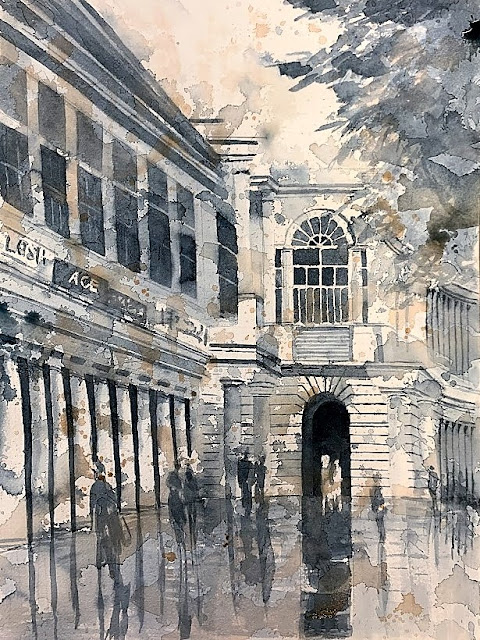Reversing the routine
Typically, watercolor is painted in layers - lightest wash, then darker, then darkest darks. When I started watercolor, I had trouble breaking down the scene in layers and putting the lightest wash over everything (but whites). I couldn't see the scene that way.
Now I can.
It seems that when I've learned how to do that, something comes along to change it up!
I took Tim Saternow's workshop last week. His basic MO is to do a value study (grisaille) under the color painting. The color is just tints - sometimes darker, but the value study shines through. And it is the value study, the very bones of the painting, that have to be strong for the painting to be strong, and to be carried.
We started with the darkest darks - once those are laid down (as Charles Reid said: you then have your values set - darkest darks and lightest lights - white of paper - down first, everything else comes in between) the painting will never be weak.
Tim said that in judging the 1200+ entries of the American Watercolor Society shows, he found that many paintings were skilfully executed, but lacked the dark darks, the punch.
This was my first painting - I was pleased with my grisaille - really, it is hard to mess that up because you see compositional improvements right away - as you would in a notan or value study devoid of color - but I went too strong with color (not shown here :-) ) My second piece was the best, because I "got it." The colors helped, not hurt. And my third - well, I was impatient, that old foe, to move on and be done with it. I was already bored with the tedium of the grisaille.
Overall, I did tend to be lighter and simply didn't put down my darkest darks - I still need to push the whole value range - whatever is darkest in my paintings needs to be the full dark value, not a 7 or 8.
Now I can.
It seems that when I've learned how to do that, something comes along to change it up!
I took Tim Saternow's workshop last week. His basic MO is to do a value study (grisaille) under the color painting. The color is just tints - sometimes darker, but the value study shines through. And it is the value study, the very bones of the painting, that have to be strong for the painting to be strong, and to be carried.
We started with the darkest darks - once those are laid down (as Charles Reid said: you then have your values set - darkest darks and lightest lights - white of paper - down first, everything else comes in between) the painting will never be weak.
Tim said that in judging the 1200+ entries of the American Watercolor Society shows, he found that many paintings were skilfully executed, but lacked the dark darks, the punch.
This was my first painting - I was pleased with my grisaille - really, it is hard to mess that up because you see compositional improvements right away - as you would in a notan or value study devoid of color - but I went too strong with color (not shown here :-) ) My second piece was the best, because I "got it." The colors helped, not hurt. And my third - well, I was impatient, that old foe, to move on and be done with it. I was already bored with the tedium of the grisaille.
Overall, I did tend to be lighter and simply didn't put down my darkest darks - I still need to push the whole value range - whatever is darkest in my paintings needs to be the full dark value, not a 7 or 8.
CONNAUGHT PLACE NOSTALGIA, 2020



Comments
Post a Comment